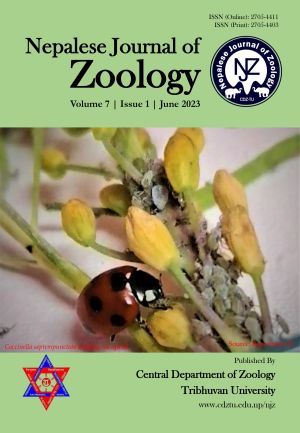Avifaunal diversity inside and outside protected area: A case of Sundarijal Forest and Changunarayan Forest, Kathmandu Valley, Nepal
DOI:
https://doi.org/10.3126/njz.v7i1.56309Keywords:
Bird diversity, Evenness, Protected area, Richness, Threatened birdsAbstract
This study aimed to compare the diversity of birds between protected and non–protected areas that are similar in climatic and geographical features. The study was carried out in three different habitat types (Forest, Agricultural land and Wetland of protected Sundarijal and Non-protected Changunarayan. Field data were collected using a “Point Count Approach” in transects which were laid in different habitat types (Forest, Agricultural land & Wetland). Shannon-Wiener and Margalef Diversity Indices were used to calculate the diversity of birds and Pielou’s Evenness was used to calculate the evenness of bird species. Also, the national and global conservation status of bird species was categorized based on the National Red List Series and IUCN Red List of Threatened Species. The result shows that, a total of 114 species of birds, of which 89 species from the Changunarayan and 80 species from Sundarijal were recorded. The overall Shannon-Weiner diversity, Pielou’s evenness, and Margalef’s richness index were higher in Changunarayan (H1 = 4.16, E1 = 0.92, and R1 = 12.85) than in Sundarijal (H2 = 3.65, E2 = 0.83, R2 =11.77). Our study has shown the highest Shannon-Weiner Index (H1=3.99) and Margalef’s richness index (R1=11.51) in Forest in Changunarayan. However, in Sundarijal, the highest Shannon-Weiner index (H2=3.49) was found in farmland and Margalef’s richness index (R2=9.54) was documented highest for the wetland. Among the total recorded species, 109 and 110 species were categorized as least concerned nationally and globally, respectively while 4 globally threatened and 5 nationally threatened species were recorded in our study site. Our study showed that both protected and non-protected areas support the diversity and richness of birds. Hence priority should be given to both areas for the conservation of birds.
Downloads
Downloads
Published
How to Cite
Issue
Section
License

This work is licensed under a Creative Commons Attribution-NonCommercial 4.0 International License.
This license enables reusers to distribute, remix, adapt, and build upon the material in any medium or format for noncommercial purposes only, and only so long as attribution is given to the creator.

